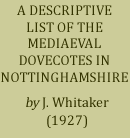THE CLIFTON DOVECOTE.
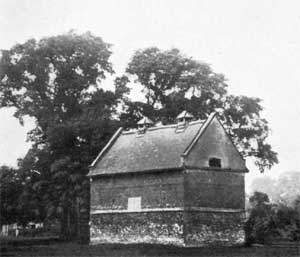 CLIFTON COTE.
CLIFTON COTE.HAD I been asked before I started to get a list of the Nottinghamshire dovecotes which was the most likely place to find one, I should have said Clifton, because Clifton belongs to one of the very oldest of our county families. It was purchased by a Sir Gervase de Clifton from a certain De Rhodes about the end of the reign of Henry the Third, circa 1260. The said Sir Gervase was Sheriff of Nottingham in 1279, so it would be almost certain to find a cote there, and there it is standing on the pretty village green near to the beautiful Clifton Grove and hard by the Queen of English rivers, the Trent. The beauties of Clifton have been sung in poetry, and upheld in prose, and it certainly is one of the beauty spots of this shire. I had written to Colonel Clifton, saying I should be there about eleven by the clock, and we arrived alongside the cote within ten minutes of our time. Colonel Clifton kindly met me there and helped me in every way to get particulars of this very fine cote. After walking round it, he unlocked the door, and as it was very dark sent for a candle, which, when lit, showed up in a faint way the rows upon rows of nesting places. I will describe the inside first. The door is four feet six high and two feet six wide, and directly you get in you see there is a partition in the middle which runs up to the square of the walls which are about twenty-four feet high. This partition is two feet nine inches wide, and has nesting places on either side. The outer walls are two feet thick. I saw at once we were among the largest lot of nesting places in any cote in Notts. I told my man (a son of my old servant, William Franks) who has driven me to most of the cotes and taken excellent photographs of many of them, to make a most careful count of the nesting places. This he did twice over, and found there were eleven hundred and fifty in each part, 2,300 in all. This is by far the greatest number in any cote in Nottinghamshire, and is one of the largest in England. These nesting places go into the walls fourteen inches, and all turn to the left. The entrance holes are five and a half inches high and six inches wide, and the landing ledges are about two and a half inches wide. The pigeons enter through two wooden glovers in the top ridge, over the middle of each part of the cote, and cords come down, which, when pulled, close up the outlet, so that any pigeons that are wanted can be caught. Outside the cote measures thirty-eight feet from east to west, and eighteen feet from north to south. There are no windows, but light in small quantity comes in through a ventilator at each end, well up to the square. The roof is covered with flat slabs of a dark brown colour. There are two string courses, one about eight feet up, and the other just under the roof. This is a fine cote, of great age, and one that not only Colonel Clifton, but all Notts. people, should be proud of.
THE BARTON COTE.
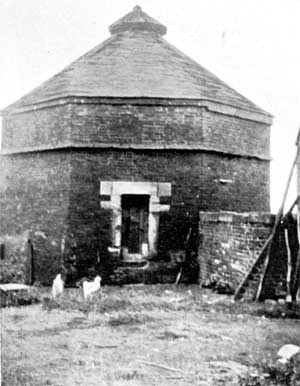 BARTON COTE.
BARTON COTE.WE got into our motors, and Colonel Clifton gave me a lead to the Barton cote. This part of the property came into the Clifton family by a marriage of one of them with a Sacheverell. It is about two miles from Clifton. This is a pretty cote, octagonal in shape, and stands in a corner of the stable-yard. It is built of bricks, early Tudor in size, which stand on a few feet of stone above the ground. It is sixteen feet high to the top of the walls, and there are two string courses, one about twelve feet up, the other just under the roof. This is a narrow one, but the lower one stands out about five inches. The door is the original one, of thick oak, and is still strong and sound. The cote measures eighty-two feet in girth. The walls are two feet six inches thick. The nesting places are of plaster, as hard as stone, and look almost as fresh as the day they were put in. They start on a brick foundation and number 1,200. The entrance holes to nests are arched four and a half inches wide and six inches high, and they go in sixteen inches. One row turns to right, the next to the left, and the landing slabs are five inches wide. These are also of cement, or as called in old days, plaster. Several of the Tudor bedrooms here have these floors. There are two windows in the roof, east and west, of small, green coloured glass in lead settings. These speak of Tudor times. The nesting holes are seven inches apart, and ten and a half inches between each row. The entrance is through a glover at the top, and there is a cord to close it up when pigeons are to be caught. On the south side is a plaster coat-of-arms, but whose they are I could not make out, probably the Sacheverells, who, no doubt, built this pretty and interesting cote. Colonel Clifton is to be congratulated on the possession of two such cotes, for to own two ancient cotes is as great a rarity as to own two deer parks. I, who have known four owners of Clifton, thank him for kind permission to see these cotes. They have greatly delighted me. I have to thank Mr. Summers, of Southwell, for giving me the photograph of the Clifton one.
THE ORSTON COTE.
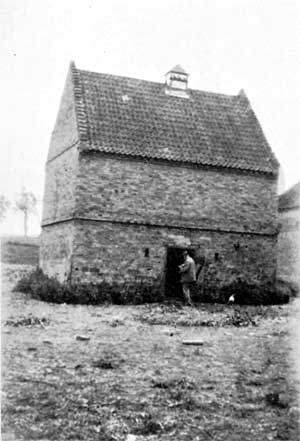 ORSTON COTE.
ORSTON COTE.WE now started on about a twenty mile run, going back to Wilford, nearly to the Bridge, but turned to the right just short of it and ran along one side of the famous Trent Bridge cricket ground, where so many great matches have been played from the days of George Parr to the present time. I attend many matches and thoroughly enjoy watching them. We ran through Bingham, and on to Orston, where in a paddock stands the Orston cote, and hard by the owner of it lives, Mr. Henry Brown. It is a brick built one. The colour of these bricks is curious, for I can only describe them as of a yellowish pink. The cote is eighteen feet from north to south, and twenty-two feet from east to west. The lower part is for fowls, and there are no pigeon nesting places in it. The door into the pigeon cote is about eight feet from the ground, not large, and of a square shape. The cote part for pigeons has walls about eight or nine feet to the square, and there are nest places to the top of the gable ends. They number in all five hundred and sixty, and go in fourteen inches. The entrances are five inches wide and six inches high, and turn to right and left in alternate rows, which are a foot between each row and about the same from each entrance. There is one string course of three bricks wide, and it stands out about four inches. It is just above the lower door. The outer walls are one foot eight inches thick. On the west side are nine entrance holes, and there are twelve in the wooden glover on the top of the roof. The outside walls in the gable have shallow crow feet about half a brick, standing edgeway between two laid flat. The roof inside is of oak, and a very primitive one. The great beam across bends much and is axe cut. The wood, however, is in good preservation, showing the roof covering, which is of tiles, has been looked after. This cote is quite one to be proud of, speaking as it plainly does of long past times. I have to thank Mr. Brown for kind permission to see it.
THE STAUNTON GRANGE COTE.
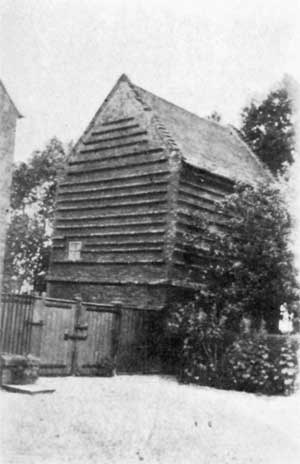 STAUNTON GRANGE COTE.
STAUNTON GRANGE COTE.AFTER leaving Orston, we felt it was time for a bit of “snap," as the colliers term it, so when about a mile away we came to a lane running from the main road. Here the hedges were thick and high. We backed into it, out of the wind, which now blew fairly strong. The sides of this lane were thick with black thorn, and when in flower I am certain the sulphur butterfly would be found here. This is one of the most local of our large butterflies. It is a very conspicuous insect, and one I always feel bound to stop and watch. It is seen here and there all over this county fairly plentiful in one place or another. When this striking insect is about in the spring the greater and lesser whites are here, there and everywhere. At this time of the year the majority of wild flowers are white and yellow, so we see that Nature has provided the flowers they most frequent should assimilate in colour with them. So it is in the autumn, when the purple loosestrife, scabious, dahlia, and other gaudy flowers are out. The red admirals, peacocks, and painted ladies, and other brilliant butterflies are about, and when on such flowers do not show them as whites or sulphur ones would. I have often wondered why the beautiful scented flowers which appeal to us do not seem to do so to butterflies. One rarely sees them on honeysuckle, hawthorn, beans or violets, but we often see then on flowers that do not appeal to us for their scents, such as ivy, Michaelmas daisies, asters, and others that are more attractive to the eye than to the nose. It was a perfect place to lunch in, with a fine view of the vale of Belvoir. The fields are of moderate size, and short of hedgerow timber, but one tree close to us was very noticable, being a well grown Lombardy Poplar, and from forty to fifty feet high. What wonderful root power this kind of tree must have, for it stands in a spot where it gets every gale, and the wind does at times blow very hard and often in this fine vale. A short run took us to the entrance drive of Mr. Player’s house at Staunton, and in days to come these nicely growing trees will make a good approach. I found Mr. Player at home, and he came with me to the cote, which stands just over the wall of the entrance yard, and a very striking cote it is, brick built and mellowed with age, and higher than is usual with this sized cote. The first thing that struck me was the sunning ledges, fifteen in number, standing out from the wall about six or more inches wide. They are on three sides, south-east and west. Never have I seen any of brick before, and only one other of wood, at Balderton, in this county. The walls are 25 feet up to the square, and are one foot six inches thick. The cote measures seventeen feet eight inches from east to west, and seventeen feet from north to south, so is almost a square, and is supposed to have been built, Circa 1590. There is one string course eight feet up over-hanging about four inches, and it is two bricks thick. The gable end walls are shallow, crow-footed. This always seems to me to add much to the appearance of the roof, which is tiled. Inside there are two small windows with the old green glass panes in them. There are 1,100 nesting places. They go into the wall thirteen inches, and are five and a half inches wide and five high. The landing ledges are about three and a half inches wide, and the holes turn alternately right and left, and are about ten inches apart and a foot between the rows. The entrance holes are on the top of the south wall and number fourteen. This is not only a very pretty building, but a most interesting one, standing by itself, and near the house. Mr. Player is to be congratulated on owning such a relic of the past. I may add there were in it about two hundred pigeons of the old blue rock breed.
THE FOSTON MUD COTE.
MR. Littler, M.R.C.V.S., of Newark, who has been most kind in getting to know where the dovecotes are, has done much to help me, and has taken some capital photographs of several of them, which has added a lot of interest to this little book. I sincerely thank him. He has sent me word of this ancient cote, which, alas, is now on its last legs. It is only a short distance over the county boundary, so I include it in my list. Mud buildings, if well protected from wet, last a great number of years, but as the roof of this one has been gone for some time is is only a matter of a few years before it will have disappeared. It is in the village of Foston, and no great distance from Staunton. Mrs. Dickinson, who showed it to me, told me the roof was a thatched one, and had been off some time. I found there had been two compartments. The walls had been ten feet high in their original state, now only two are left. They are two feet six inches thick. The nesting places left now number about one hundred and seventy. They are nine inches deep, and eight inches high, and ten wide at entrance, so the nests and eggs would be easily seen by anyone standing inside. To me it was sad to see the decay of a once inhabited dovecote.
THE DRY DODDINGTON COTE.
THIS cote is just over the boundary of Nottinghamshire. Leaving Foston, which is on the Great North Road, we ran through Long Bennington, a large village with some nice houses in it, and after a short distance, twisted to the right, and in a few minutes we arrived at Dry Doddington. The Church spire leans considerably towards the northwest, quite a perceivable lean, and close by it in an orchard stands the dovecote. It is a square building of stone, and measures twenty feet by twenty, and is fifteen feet up to the top of the walls. The string course is nine feet up, and is cut hollow on the lower side, making it impossible for vermin to get over it, and the only one that I have seen so shaped. This runs only on two sides of the cote, viz., on the north and east. Why not all round I know not. There are nine entrance holes, and also eight in the glover on the top, which has a rope inside to close it up when pigeons are to be caught. The roof is tiled, and the inside is rather dark. The walls are three feet thick, and very solid. The door is a large one, six feet high and three wide, a quite exceptional size, as it cannot be seen from the house, but probably it has been renewed and is larger than the original one. The nesting places go in fifteen inches deep. They are eight inches wide and six and a half high, and each has a tongue-shaped stone landing place. The nesting places at the end in one row turn to the right, and the next row to the left. There is fourteen inches space between each entrance and ten inches between each row. There are five hundred and thirty-seven nests. The wood in the roof is oak, axe cut, and is the original. This cote is no doubt of a goodly age, and as the walls are wonderfully stout, will, if the roof is kept in order, stand for many generations. It reminds me much of the one at South Scarle, near Newark. The Dry Doddington cote is on Mr. Grammit’s Farm, and I thank him for showing it to me.
THE COTE AT MORTON MANOR.
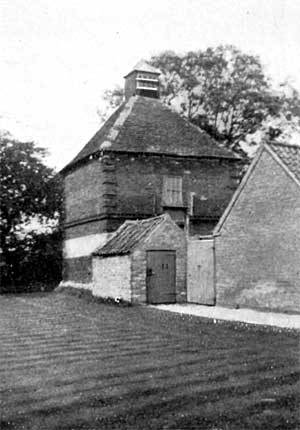 MORTON MANOR COTE.
MORTON MANOR COTE.ON August the 6th, I started about 1.20 p.m., to see the last of the dovecotes on my list, and I have tried in every way to get a complete one, thanks to several newspapers and many friends, whom I most sincerely thank. I hope that I have not missed a single one. I may truly add I felt sorry that this was the last of the great dovecotes that I was on my way to see, for I have most thoroughly enjoyed these pleasant outings. They have enabled me to see many parts of Nottinghamshire where I had never been before, and all of them had their own special beauty, whether in a hilly part or in a sweeping vale, and as the weather up to now has been showery the fields and trees have retained their vernal colours later than usual, and looked more like late spring than mid-summer. The kindness of the owners and tenants of each cote has enabled me to give a clear and true account of them, which will, I hope, interest my readers, and be of value to those who come after us, for I am quite sure it is only a matter of time, and not a very long time, before they will be things of the past, or have been put to a different use. It is perfectly clear that farmers and owners of land would never permit hundreds of pigeons to frequent their fields as was the case a hundred years ago, and it will only be buildings like Clifton that will survive and be a home for a few blue rocks, pigeons, which in a very small way will give our descendants a slight idea of what things looked like when great dovecotes in scores were scattered about this country and pigeons in their hundreds inhabited them.
It was a very hot day, about the warmest of the few we have had this year, and the way was pretty. We ran through Oxton and lunched on the roadside at the top of the hill. Here was a beautiful view to the south and north-west. Then on to Halam, where we got a photograph of the large cote which I have before described. Next through Southwell, to Morton Manor, where Mr. Richard Wright, the owner of the cote, gave me a hearty welcome, and took me to the cote which stands near the house on one end of the lawn. It is a structure of interest, of Tudor times, of pretty brick work, and of a square, seventeen feet, and fifteen feet high to the top of the walls. The roof is covered with small, flat, brown tiles. On the top is a glover with eight entrance holes, and below are nine more on the top of the wall. There is one string course of three rows of bricks standing out about three inches. The middle row has the bricks laid in slanting sort of steps, edgeways on, which gives to the course a smarter appearance. The door, a fairly new one, is two feet nine inches wide and five feet six high, and is in sight of the house. The old door is near, and has the very old lock and key on it. The key is a very curious one, short, with a big bell-like mouth. On entering, I was much struck with the wall. It is only one brick thick. Most cotes are eighteen inches, and many three feet or more, but to add to the strength each corner of the wall is eighteen inches. This acts as four strong pillars to suport the roof. These corners have inside a strong post, of oak, axe cut, which at the bottom go into the cement floor and to the top of the walls above, and not only act as strengtheners to the walls, but permit the nesting boxes which are all of wood, being fastened on to rails which are nailed to them. These boxes are in square frames of thirty, on all the walls. Now only a few squares are left just to show what they were like. The cote has lately been turned into a place to hold the machine for the electric lighting of the house and buildings. These wooden nesting places, when it was a dovecote, numbered six hundred, and are of the following size:— Eleven inches deep, the holes are eight inches wide and seven and a half inches high, and the alighting ledges are three inches wide, and, like the nesting boxes, are of wood. The rows are about a foot apart. The holes in the glover at the top can be closed by pulling a cord which hangs down. This was done when pigeons were to be caught. I may add the foundations of the walls are of stone up to about two feet, and on the outside the corners have a column-looking appearance, as, after four courses of bricks being flat, the next two stand out about two inches. This breaks the flat look and improves the outline of the ends. The inside of the roof has been repaired in later days, as part of the wood is deal, saw cut, and part of oak, cut with the axe. A nice cote, and from the front door looks well. On the side of the lawn stands an elm tree, one of the finest in the vale. Its girth at four feet from the ground is twenty-feet six inches. I know of no finer one in Notts., and there are few bigger anywhere else I should say. It is an English elm, not a witch elm. I congratulate Mr. Wright on having such a tree, and such an interesting dovecote.
THE WORKSOP MANOR COTE.
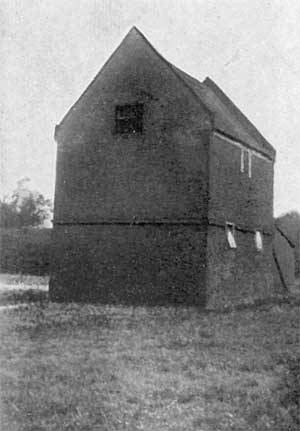 WORKSOP MANOR COTE.
WORKSOP MANOR COTE.WHEN I visited the Morton Manor cote, on August the 6th, I felt certain it was the last one in this shire I should see, because I had done all I could possibly think of to get a complete list. But shortly after the date named I had a letter from Lady Robinson, stating she thought they had one. It struck me at once that Worksop Manor was a very likely place, so I wrote saying I would certainly come, but engagements prevented my doing so till September the 24th. I motored over, received a hearty welcome, and was delighted to see my old friend, Sir John, looking so fit and well. He is in his eighty-ninth year, and still takes the greatest interest in his estate and stud of thoroughbreds. He is up in a morning early, and has a ride round before breakfast, and if I was going to enter anyone for the hundred year old stakes, he would be my nomination. After lunch we motored to Blyth, as Lady Robinson thought she had seen two likely-looking buildings, but though they each had a pigeon-cote on the top, they were not dovecotes proper, as the lower parts were stables, the middle, corn chambers, and had not been built for pigeons alone. They probably had been erected early in the 18th century, and each contained over eight hundred nesting places. We now started for the Hawk’s Nest Farm, where the Worksop Manor cote was. This farm is mentioned in Doomsday book, and in those times would be deep in Sherwood Forest. I saw at once, on arrival, that this was a true dovecote. It stands away from the other buildings in a grass paddock, and is of brick, which bricks plainly tell its age. They are two inches thick, nine long and four wide, and are still hard, or harder than stone. The roof is now tiled, probably thatched when first built. The cote measures eighteen feet from east to west, and twenty feet from north to south. There is one string course of two bricks thick, eight feet up, and there are two entrance places, one on the east and the other on the west. Each have eight holes. The entrance holes to the nests are six inches wide by six high, and the landing ledges are three inches wide. The nesting holes go in sixteen inches deep, and the ends turn to the right in one row and to the left in the next, and are nine inches between each row. The walls are two feet thick, and are about eighteen feet to the square. The lower part of the cote has been turned into a loose box for mares, and the floor over it is about ten feet from the ground. The number of nesting boxes now are four hundred and forty-eight, and Sir John told me, when he bought the estate in 1890, that the whole of the walls had nesting places in them, so then there would have been quite one thousand or more. This cote was most probably built when the Tudor house was erected. This great house contained five hundred rooms, and was completely burned down in 1761. It had been built in 1530-1570, and no doubt the dovecote was built during those years. The old oak beams are in the roof, and are still sound and good. It is a plain, but well-built cote, and I congratulate its owner on his possession of so interesting an object.
MY pleasant task is over,
My little book is done;
I’ve passed by fields of clover,
’Neath spring and summer’s sun.
I’ve beard the corncrake calling,
In meadows wet with dew;
I’ve felt the soft rain falling,
And seen how corn crops grew.
I’ve loved these country rambles,
In April, May and June;
Now fruit is on the brambles,
From birds we have no tune.
I certainly have striven,
A clear account to give;
And thank all friends who’ve given,
The dovecotes that still live.
J. WHITAKER.
September, 1927.
Rainworth Lodge.
